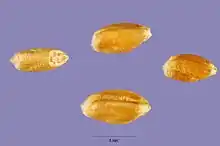Triticum carthlicum
Triticum carthlicum Nevski, 1934,[1] the Persian wheat,[2] is a tetraploid wheat.
| Persian wheat | |
|---|---|
 | |
| Scientific classification | |
| Kingdom: | Plantae |
| Clade: | Tracheophytes |
| Clade: | Angiosperms |
| Clade: | Monocots |
| Clade: | Commelinids |
| Order: | Poales |
| Family: | Poaceae |
| Subfamily: | Pooideae |
| Genus: | Triticum |
| Species: | T. carthlicum |
| Binomial name | |
| Triticum carthlicum Nevski, 1934[1] | |
Some scholars refer to it as Triticum turgidum subspecies carthlicum..[3] Recent research suggest that T. Carthlicum originated from a cross between domesticated emmer wheat and T. aestivum.[4][5]
References
- "Triticum carthlicum Nevski". The Plant List.
- "Triticum carthlicum". Natural Resources Conservation Service PLANTS Database. USDA. Retrieved 16 December 2015.
- "Experimental studies on species relationships in T. turgidum ssp. carthlicum and T. aestivum ssp. carthlicoides". Metzger, Robert J., Kronstad, Warren, Myrold, David, Mok, David, Broich, Steven. 1985-07-29. Cite journal requires
|journal=(help)CS1 maint: others (link) - De Oliveira, Romain; Rimbert, Hélène; Balfourier, François; Kitt, Jonathan; Dynomant, Emeric; Vrána, Jan; Doležel, Jaroslav; Cattonaro, Federica; Paux, Etienne; Choulet, Frédéric (18 August 2020). "Structural Variations Affecting Genes and Transposable Elements of Chromosome 3B in Wheats". Frontiers in Genetics. 11: 891. doi:10.3389/fgene.2020.00891.
- Matsuoka, Y. (1 May 2011). "Evolution of Polyploid Triticum Wheats under Cultivation: The Role of Domestication, Natural Hybridization and Allopolyploid Speciation in their Diversification". Plant and Cell Physiology. 52 (5): 750–764. doi:10.1093/pcp/pcr018.
Bibliography
- E. R. Kerber; V. M. Bendelow (1977). "The Role of Triticum carthlicum in the Origin of Bread Wheat Based on Comparative Milling and Baking Properties". Canadian Journal of Plant Science. 57 (2): 367–373. doi:10.4141/cjps77-053.
- W. Bushuk; E. R. Kerber (1978). "The Role of Triticum carthlicum in the Origin of Bread Wheat Based on Gliadin Electrophoregrams". Canadian Journal of Plant Science. 58 (4): 1019–1024. doi:10.4141/cjps78-155.
This article is issued from Wikipedia. The text is licensed under Creative Commons - Attribution - Sharealike. Additional terms may apply for the media files.